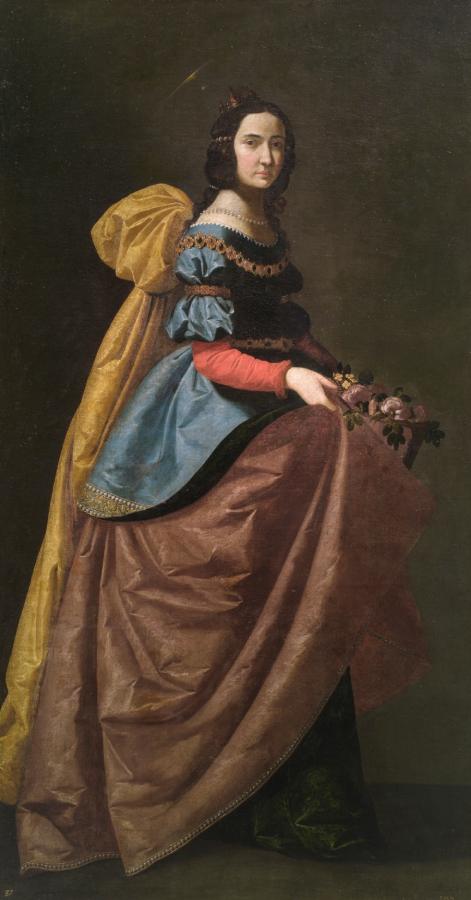Zurbarán, Francisco de (1598-1664)
Santa Isabel de Portugal
c.1635
Oil on canvas, 184 x 98 cm
Museo del Prado, Madrid
Born as princess of Aragon in 1271, the daughter of Peter III “the Great” and grand-daughter of James I “the Conqueror” married King Dinis of Portugal in 1293 and became queen of the country. Like her great-aunt Saint Elizabeth of Hungary, with whom her iconography is often confused, she led a deeply Christian life of charity and sacrifice. When her husband died in 1325 she took her vows as a Clarissan nun and joined a convent in Coimbra, where she died in 1336. Her life story includes an account of a miracle that gives rise to the iconography with which she is commonly represented and which Zurbarán uses here. Her charity towards the poor spurred her give away much of her own riches, which she concealed among the folds of her robes as her despotic husband forbid her to give alms. One day King Dinis surprised her in these circumstances and attempted to discover the hidden money, but all he found was a bunch of roses, even though the episode took place in mid winter. This is why Saint Elizabeth of Portugal is depicted with a bunch of roses on her lap, although this iconography is also shared with Saint Casilda, whom the painting was believed to represent until fairly recently. However, Saint Casilda is generally portrayed with more youthful features, whereas here Saint Elizabeth is appropriately crowned as queen, is attired in sumptuous dress and appears somewhat mature in years. Of the numerous paintings of female saints Zurbarán produced throughout his lifetime, this is one of the finest and most technically perfect. Its stylistic features allow it to be dated to an early period in the artist’s career, around 1635. The saint is shown full length, leaning slightly rightwards, silhouetted against a background of semidarkness. A powerful light from the left intensely highlights her presence, which stands out with a clear volume. The left side of the body is flooded in a luminosity that gradually fades toward the right. Her eyes gaze at the viewer with determination and dignity, and her facial features are highly personal, suggesting that the artist used a real model. The skill with which Zurbarán has painted the textures of the fabrics of the saint’s opulent robes is remarkable, particularly the complex arrangement of the folds. Her head, neck, bosom and forearm also display splendid jewels that are depicted in detail, and the flowers on the saint’s lap are superbly rendered. As for the concept of the work, given the subject matter, one of the many images of female Christian saints Zurbarán painted, we should consider whether it should be regarded as a strictly religious image designed to be displayed in a public church or as a “retrato a lo divino”, a person portrayed as a saint, as Orozco Díaz suggested in connection with paintings of this type. If we take the hypothesis that it is a portrait of a noblewoman in secular dress, we are dealing with the likeness of a lady of high social position, most likely of Seville, and the work thus loses its fully devotional meaning to become a portrait, albeit bearing the attributes of a Christian saint. (De Tiziano a Goya. Grandes maestros del Museo del Prado, Madrid, Museo Nacional del Prado SEACEX, 2007, p.218).
See also:
• Isabel de Portugal, St. (1271-1336)
